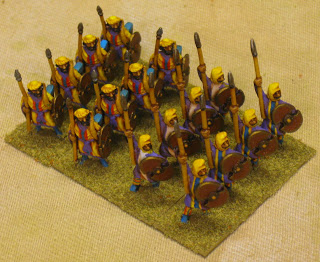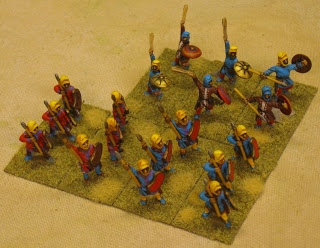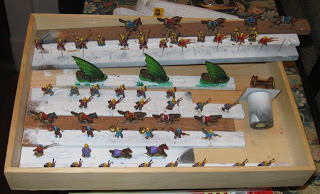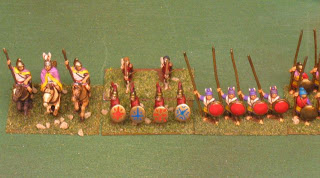DBA, or De Bellis Antiquitatis, is a miniature wargame for recreating battles from the ancient through medieval periods (aorund 3000BC-1400AD). Each player chooses an army of 12 elements from the list of 300 or so armies in the book. It takes only about an hour to complete a game. The rules are easy (though the rule book is unintelligible), but the tactics can be subtle.
The Double DBA variation allows playing larger games: two 12-element armies are used per side, and it facilitates more than 2 players a lot better than normal DBA. The rules don’t change, but the additional tactical complication can make the game take a lot longer.
Last night, 3 of us played a game of Double DBA for the first time. I played the Skythians (I/43a) and Later Achaemenid Persians (II/7) against Frank playing the Alexendrian Macedonians (II/12) and Andy playing Later Spartans (II/5a). These are all historically contemporary armies: Alexander was the enemy of all three of the others, and Persia and Scythia were allies at some times. I don’t have Alexander’s only ally army, so we faked it with the Spartans.
I chose the most infantry possible with my armies: only 10 out of 24 elements. In contrast they had as much cavalry as possible, which is only 4 out of 24. So they were very different armies: theirs was a long, slow, strong infantry line, and mine was mostly highly maneuverable light horse lacking any real punch.
My other big choice in army composition was whether to use Auxilia or Spear for my Persian infantry block. The rest of my foot is Auxilia and Psiloi, which are both good in bad terrain. Spear wouldn’t be good in bad terrain, and with such a short infantry line, they’d be easy to outflank and kill out the open. So, I chose the Auxilia, since I could probably hide them in some bad going to keep them safe.
I ended up rolling as the defender, and setting up terrain. I put bad going in the middle front of each deployment zone, and some on each flank. This allowed me to guarantee hiding my infantry, while putting a hole in the enemy line. The terrain on the flanks wasn’t that big of a problem, but they did constrain deployment more than I thought. I shouldn’t have put the bad going in the middle of the table on both sides: this caused their army to gap exactly where my infantry was placed, instead of encouraging them to confront me in the bad going.
The bigger mistake I made was in deployment. I put my light horse too close to the center, with no efficient way to move them out to the flank. That wasted a lot of PIPs and caused trouble.
The Spartans are almost entirely spear, and Alexander’s primary infantry is Pikes. Those cannot kill my Light Horse or Cavalry at all, without flanking them. Their other option for killing my elements was to go into the terrain to push out my light infantry. They’re easier to kill, but it would require a lot more commands to get into combat because of the bad going. On the other hand, I had to set up some really useful combats in order to get any chance of killing any of his elements with my weak Light Horse.
For a while, the lines approached each other uneventfully, and I tried to extract a few light horse from the center around to the flank. I lost many combats, as I expected, with my light horse fleeing. Eventually Andy and Frank exploited gaps in my line to flank my elements that hadn’t fled yet, and I started losing some units. However, exploiting a hole with a pike block means breaking your line, and this helped me get into a much better position against them.
8 elements or both generals dead means you lose. I lost about 4 elements before I killed anything. It got pretty grim: I was behind by about 6-3 at the worst. But then things started turning around when they stopped getting any PIPs (commands) for a while, and I was able to more effectively fold Frank’s flank. I eventually caught up, killing 8 (including a general) to their 6.
Overall, it was very enjoyable, but it took closer to 4 hours than 1. I admit, a lot of this was involved in not actually playing the game, and we could be a lot faster with more experience. I’d certainly play again if everyone was interested, but I’d be almost as happy playing a few ordinary DBA games, since they’ll make everyone better at playing more quickly.
I liked the very different feel of the armies, but I think this particular matchup created a quite slow game, since most of the combats were numerically very unlikely for me to win, but also impossible for them to kill me. Clearly I need to paint a few more armies so we can have more double DBA options!
















